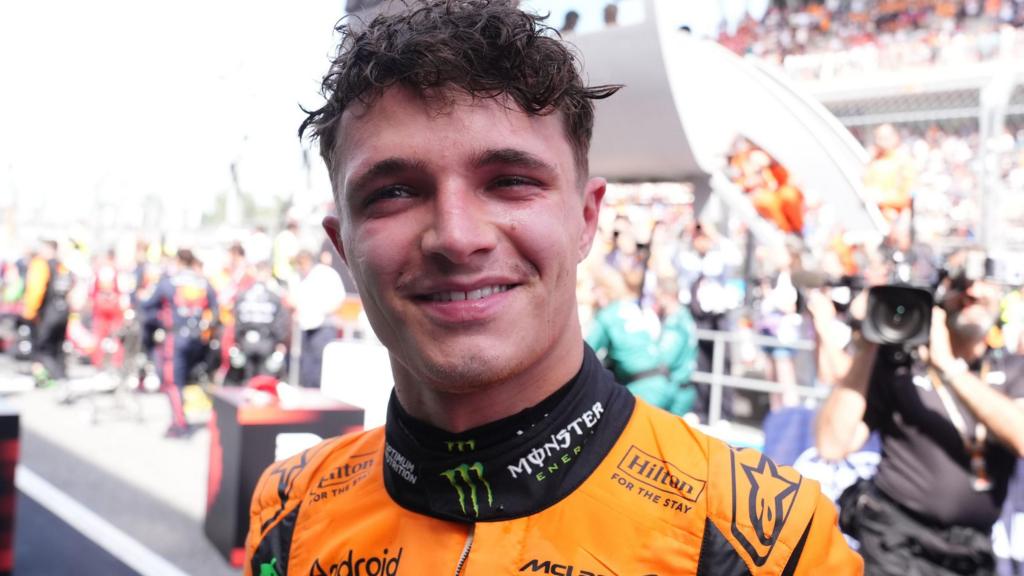Video Playback Error
Norris Content Despite Imperfect Season Start
“I want to do it my way,” Lando Norris states, a sentiment reflecting his current position over a third of the way into a Formula 1 season that could culminate in a world championship.
The McLaren driver, speaking from the team’s factory ahead of the Canadian Grand Prix, contemplates several key factors. These include his internal competition with teammate Oscar Piastri; his strategic approach to racing against championship contender Max Verstappen, whose recent actions in Spain were controversial; and Norris’ own challenges in maximizing the performance of his McLaren car, a top contender despite his admitted struggles this season.
Currently, he’s analyzing his and his team’s strategy in managing two closely matched drivers in a top-performing car. The focus is on enabling fair competition while preventing internal conflict, a common pitfall in F1 history.
McLaren is prioritizing team unity while supporting the individual ambitions of Norris and Piastri. So far, this approach has proven successful.
“I think it’s because I’m a great teammate,” Norris says with a smile, adding, “Even though your teammate is always your biggest competitor, I’ve always prioritized having a good time and enjoying the journey. We want to do that together. We’re different, but we both want to beat each other, yet cherish the experience.”
Maintaining amicable relations between teammates while vying for the sport’s ultimate prize is a rarity in F1. Drivers are inherently competitive, and personal ambition often overshadows team harmony. History is rife with examples of such rivalries: Mansell and Piquet, Senna and Prost, Hamilton and Alonso, Hamilton and Rosberg.
McLaren is attempting a unique approach in modern F1. While anticipating some friction, they believe their transparent communication strategy can mitigate potential problems. The contrasting personalities of Norris and Piastri—Norris’s openness versus Piastri’s reserved demeanor—make this unusual collaboration intriguing.
“I’m employed by the team, and my priority is McLaren,” Norris explains. “We’ve witnessed many teammate rivalries turning sour, leading to a cascade of failures. We want to avoid that. We’re free to race each other, but our ultimate goal is to compete for McLaren. We are both proud to do that.”
McLaren believes this collaborative approach enhances their collective performance compared to a traditional hierarchical structure. Norris acknowledges both advantages and disadvantages to this dynamic, noting that while mutual observation facilitates learning, it elevates the team’s overall performance.
McLaren leads the constructors’ championship with 362 points, significantly ahead of Ferrari. Last year, Norris dominated; this year, Piastri is ahead, boasting six wins to Norris’ two, and a 10-point championship lead.
Norris views the season’s start as “not perfect,” yet remains optimistic. Piastri’s success, he says, is unsurprising given his talent and driving style. Norris, having close proximity to Piastri, has unique insight into his capabilities.
Both Norris and team principal Andrea Stella have acknowledged a specific car characteristic affecting Norris’ performance, described as a “numb” front axle. This impacts Norris’ reliance on steering wheel feedback, hindering his performance against top competitors. He’s adapting by utilizing other sensory cues and working closely with the team to improve steering feedback.
Norris previously compared Verstappen’s collision with George Russell to a Mario Kart incident. While declining to elaborate further, he addresses the challenge of racing Verstappen. He respects Verstappen’s abilities and accomplishments, acknowledging their differing racing styles while maintaining that stewards ultimately determine fair play.
On Verstappen’s racing philosophy—as expressed in a previous BBC Sport interview—Norris remarks that intense competition requires adapting. While overtaking on the outside is challenging, prioritizing race completion is crucial to success.
Addressing his self-belief, Norris acknowledges his confidence in his driving abilities, aiming for consistent top performance. He asserts that his belief in his potential as a top driver motivates his Formula 1 pursuit.
Should McLaren Prioritize One Driver?
Meet F1’s Coolest, Calmest Driver
How to Watch the Canadian Grand Prix on the BBC
Madrid’s F1 Debut, Imola Dropped from 2026
Comments Loading Error
Enable JavaScript to view comments.

